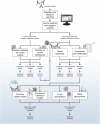Garbage in, garbage out: a critical evaluation of strategies used for validation of immunohistochemical biomarkers
- PMID: 24725481
- PMCID: PMC5528533
- DOI: 10.1016/j.molonc.2014.03.008
Garbage in, garbage out: a critical evaluation of strategies used for validation of immunohistochemical biomarkers
Abstract
The use of immunohistochemistry (IHC) in clinical cohorts is of paramount importance in determining the utility of a biomarker in clinical practice. A major bottleneck in translating a biomarker from bench-to-bedside is the lack of well characterized, specific antibodies suitable for IHC. Despite the widespread use of IHC as a biomarker validation tool, no universally accepted standardization guidelines have been developed to determine the applicability of particular antibodies for IHC prior to its use. In this review, we discuss the technical challenges faced by the use of immunohistochemical biomarkers and rigorously explore classical and emerging antibody validation technologies. Based on our review of these technologies, we provide strict criteria for the pragmatic validation of antibodies for use in immunohistochemical assays.
Keywords: Antibody reliability; Antibody validation; Biomarker discovery; Immunohistochemistry; Workflow.
Copyright © 2014 Federation of European Biochemical Societies. Published by Elsevier B.V. All rights reserved.
Figures




References
-
- Algenas, C. , Agaton, C. , Fagerberg, L. , Asplund, A. , Bjorling, L. , Bjorling, E. , Kampf, C. , Lundberg, E. , Nilsson, P. , Persson, A. , Wester, K. , Ponten, F. , Wernerus, H. , Uhlen, M. , Ottosson Takanen, J. , Hober, S. , 2014. Antibody performance in western blot applications is context-dependent. Biotechnol. J.. 9, (3) 435–445. - PubMed
-
- Anderson, L. , Hunter, C.L. , 2006. Quantitative mass spectrometric multiple reaction monitoring assays for major plasma proteins. Mol. Cell Proteomics. 5, (4) 573–588. - PubMed
-
- Asplund, A. , Edqvist, P.H. , Schwenk, J.M. , Ponten, F. , 2012. Antibodies for profiling the human proteome – the human protein atlas as a resource for cancer research. Proteomics. 12, (13) 2067–2077. - PubMed
-
- Baker, A.F. , Dragovich, T. , Ihle, N.T. , Williams, R. , Fenoglio-Preiser, C. , Powis, G. , 2005. Stability of phosphoprotein as a biological marker of tumor signaling. Clin. Cancer Res.. 11, (12) 4338–4340. - PubMed
-
- Bartlett, J.M. , Thomas, J. , Ross, D.T. , Seitz, R.S. , Ring, B.Z. , Beck, R.A. , Pedersen, H.C. , Munro, A. , Kunkler, I.H. , Campbell, F.M. , Jack, W. , Kerr, G.R. , Johnstone, L. , Cameron, D.A. , Chetty, U. , 2010. Mammostrat as a tool to stratify breast cancer patients at risk of recurrence during endocrine therapy. Breast Cancer Res.: BCR. 12, (4) R47 - PMC - PubMed
Publication types
MeSH terms
Substances
LinkOut - more resources
Full Text Sources
Other Literature Sources

